Note: If an image ever fails to appear - refresh your page, it really is there
Flags of Rhodesia and Zimbabwe
Zimbabwe is a land-locked country in southern Africa which was previously called Rhodesia. Rhodesia had been named after Cecil John Rhodes whose British South Africa Company colonized the territory in the late 19th century. Following a referendum in 1922, the territory became a "British Colony with Responsible Government." What this meant was that there was a local parliament although some powers (notably relating to African political advancement) was retained by London. The Colony was ruled via the Dominions Office (and not the Colonial Office) although strictly speaking the country was not a Dominion (like Canada, Australia, South Africa etc.). This was a unique case.
In 1965 its white minority government declared a "Unilateral Declaration of Independence" from the United Kingdom. This was not recognised and the country was considered to be in "rebellion against the Crown". All colonial ties were formally severed in 1970 when Rhodesia declared itself a republic. Following a short return to British rule in 1979, the country achieved its independence as the Republic of Zimbabwe in April of 1980 under an African majority rule.
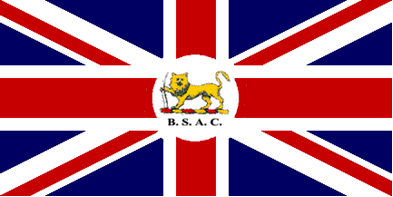
BSAC Flag
(plain variant)
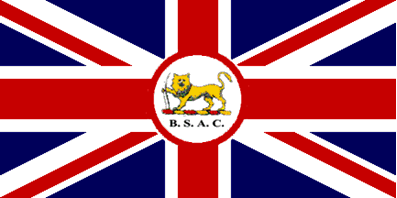
BSAC Flag
(red ring around badge variant)
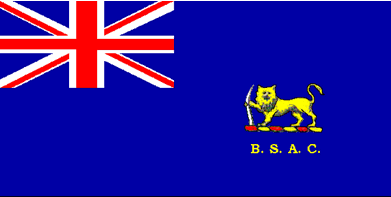
BSAC Blue Ensign
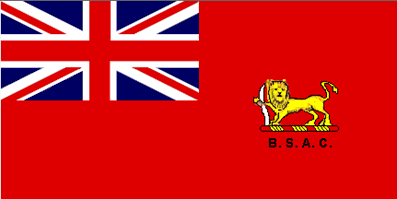
BSAC Red Ensign
|
British South Africa Company 1890-1923)
Between 1890 and September 1923 the territory now known as Zimbabwe was administered by the British South Africa Company (BSAC) in terms of a Royal Charter granted to Cecil John Rhodes by Queen Victoria. The Charter empowered the BSAC to, inter alia, make treaties, promulgate laws, preserve the peace, maintain a police force, acquire new concessions and generally provide, at the Company's expense, the infrastructure of a new Colony.
The first flag of sovereignty flown over what is now Zimbabwe was the British Union Flag (Union Jack) raised at Fort Salisbury on 13 September 1890, which marked the beginning of prolonged British influence in the region. The BSA Company's own flag had not been received from England when the Pioneer Column - financed by Rhodes and whose mission was to establish 'control' of Mashonaland - set out from South Africa, so a Union Jack was carried instead, the first company flag only arriving in Fort Salisbury in 1892.
The Company flag consisted of a Union Jack emblazoned with the BSAC badge in the centre. The badge comprised a yellow lion holding an elephant's tusk and standing on a red and yellow wreath; under the wreath were the letters B.S.A.C. in black. The badge was derived from the crest of the arms granted to the BSAC twenty years after it received its royal charter.
The Company flag was not described in detail in the royal charter and the lack of such a description probably accounts for the discrepancies and different versions of the company flag which came into use. The most important anomaly in the flag design relates to the incorporation of a red ring surrounding the badge in some instances and being absent in others.
Two other Company flags were designed. These were the British Blue and Red Ensigns with the company badge in the fly. In the case of the red ensign version the badge is depicted above the black initials of the Company in the centre of a white disk while in the blue ensign version the disc is omitted and the lettering is in gold and imprinted directly on the flag. Ensigns are primarily intended for use as maritime flags and although the company's possessions never included a coastline, it was empowered in terms of its charter to own or operate ships. In all probability these ensigns were never used although they do appear on flag charts from that period.
The end of the Company administration came with the granting of Responsible Government to Southern Rhodesia by the British Government on 13 September 1923. After being relieved of its political obligations, the Company continued to manage a wide range of agricultural, mining and commercial interests in both Southern and Northern Rhodesia until it amalgamated with the Anglo-American Corporation in 1965.
|
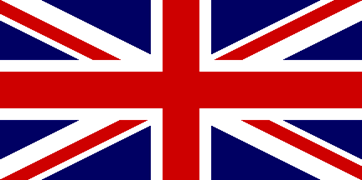
British Union Flag
|
Southern Rhodesia 1923-1968
Following the granting of Responsible Government, Southern Rhodesia became a British Colony and the British Union Flag became the official flag.
A dual flag policy later came into effect when distinctive Rhodesian ensigns were also used and flew side by side with the Union Flag.
The Union Flag ceased to be an official flag following Rhodesia's Unilateral Declaration of Independence (UDI) from Britain and the adoption of a new flag on 11 November 1968.
|
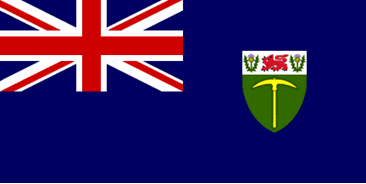
Southern Rhodesia 1937
(plain version)
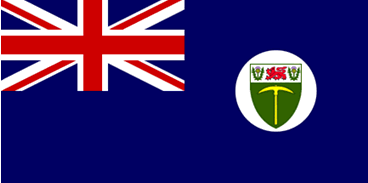
Southern Rhodesia 1937
(shield in roundel version)
|
Southern Rhodesia 1937-1953
There was considerable confusion as to what was the flag of Southern Rhodesia following the granting of Responsible Government. The British Union Flag was considered the official flag of the Colony until 1937 when the Admiralty approved a Southern Rhodesian dark blue ensign, although evidence suggests that such a flag may have already been used prior to this date.
The Admiralty approval specifically stated the blue ensign as being for use outside the colony only while the Union Flag remained the official flag and thus continued to fly within the colony.
Not only was the usage of the flag confused, but so were the exact details of the ensign. Versions with the shield from the Colony's Arms placed directly in the fly and sometimes within a white roundel were used.
There are also examples of red ensign versions in the same designs, although these were not approved by the Admiralty.
|
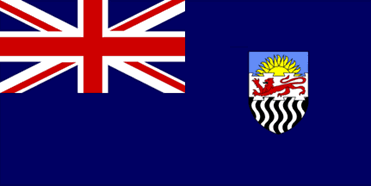
FRN Blue Ensign 1953
|
Federation of Rhodesia and Nyasaland 1953-1963
The Federation of Rhodesia and Nyasaland was established on 07 September 1953 following the amalgamation of Northern Rhodesia, Southern Rhodesia and Nyasaland.
The flag of the Federation was a British blue ensign with the shield from the Federal coat of arms in the fly. The shield was an amalgam of those of the participating territories. The rising sun in gold came from the shield of Nyasaland, the red lion from that of Southern Rhodesia and the six vertical black and white wavy 'pallets' representing the Victoria Falls came from that of Northern Rhodesia. Within the Federation, this flag flew alongside the British Union Flag in a dual flag arrangement.
The Federation was dissolved on 31 December 1963 following which each territory assumed a separate political identity.
|
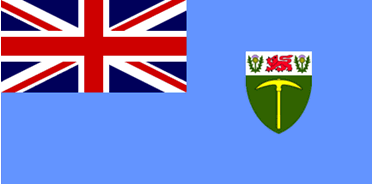
Southern Rhodesia Flag 1964
|
Southern Rhodesia 1964-1968
After the breakup of the Federation of Rhodesia and Nyasaland, Northern Rhodesia became the independent republic of Zambia and Nyasaland became Malawi under African leadership during 1964. Southern Rhodesia wanted independence on the same lines but the British Government refused on the basis that not enough was being done regarding the political advancement of the African population.
A new flag for Southern Rhodesia was raised for the first time on 22 April 1964. This was a light (Royal Air Force) blue ensign with the shield from the coat of arms in the fly. The main motivation for adopting the light blue background, as opposed to the traditional dark blue, was that it was felt that a clear break had to be made from the situation before and during the Federal period, which most white Rhodesians felt very emotional about, particularly their perceived poor treatment by the British government during the dissolution of the Federation.
Unlike with the previous Southern Rhodesian dark blue ensign, this version always had the shield placed directly in the fly without the disc. This flag continued to be used after Rhodesia's Unilateral Declaration of Independence (UDI) on 11 November 1965 until it was replaced in 1968.
|
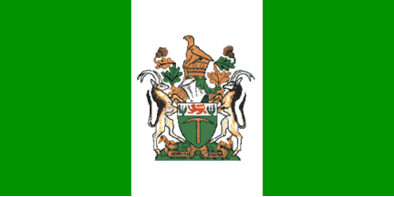
Rhodesia Flag 1968
|
Rhodesia 1968-1979
The independence of Rhodesia (having dropped the "Southern" after the independence of Zambia in 1964) was not recognised and mandatory economic sanctions were imposed on the 'rebel' colony by the United Nations.
To signify the severing of colonial links, a new flag was adopted on 11 November 1968 which was three vertical stripes of green, white and green with the national coat of arms in the centre of the white stripe.
This flag was used until 01 September 1979 when it replaced by the flag of Zimbabwe Rhodesia.
|

Zimbabwe Rhodesia Flag 1979
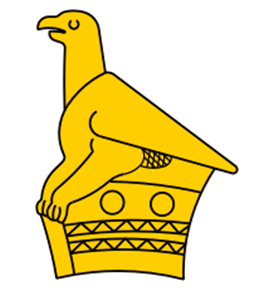
Detail of what will become
the Republic of Zimbabwe's
National Emblem in 1980
|
Zimbabwe Rhodesia 1979
African opposition to the Unilateral Declaration of Independence (UDI) and the white-led regime in Rhodesia manifested itself through an increasing guerrilla struggle waged initially from neighbouring Zambia and then also from Mozambique. In 1978 the Rhodesian Government reached a compromise with the internally-based African leaders resulting in universal suffrage elections in February 1979. This led to the establishment of a African dominated government and the formation of Zimbabwe Rhodesia on 01 June 1979. As the externally based guerrilla leaders were not accommodated, the new state was not recognised and UN sanctions were maintained and the guerrilla struggle continued.
A new flag to reflect the changing political dispensation was hoisted on 02 September 1979. This flag has a vertical black stripe, with white fimbriation, at the hoist, with three horizontal stripes of red, white and green in the fly. A yellow Zimbabwe Bird was on the black stripe in the canton.
Black symbolized the achievement of majority rule in the country, red stood for the struggle for independence, yellow represented the mineral wealth and green the agricultural and natural resources of the country. The vertical white stripe represented the white community while the central horizontal white stripe stood for peace.
Officially this flag was short-lived as it was replaced on 12 December 1979 by the British Union Flag when Zimbabwe Rhodesia once again became a British colony and reverted to its formal colonial name of Southern Rhodesia.
|
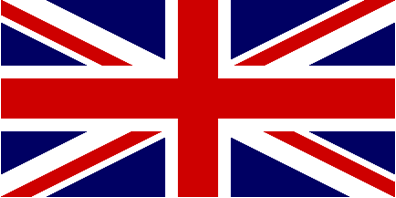
British Union Flag
|
Southern Rhodesia 1979-1980
Negotiations held at Lancaster House in London under the auspices of the British Government resulted in a ceasefire and the arrival of a British Governor on 12 December 1979. In terms of the Lancaster House Agreement, Rhodesia reverted to being a British Colony under direct control from London. UN sanctions were lifted and legality was restored.
The British Union Flag was also reinstated. While de jure the British Union Flag was the official flag of the country, de facto the Zimbabwe Rhodesian flag continued to fly until the new flag of Zimbabwe was adopted at independence on 18 April 1980.
|
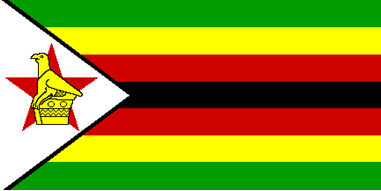
Zimbabwe Flag 1980
|
Republic of Zimbabwe 1980 -
Zimbabwe obtained its independence from Britain on 18 April 1980 and adopted a new flag based on the colours of the ruling party. The flag has seven horizontal stripes and a white triangle at the hoist, in the centre of which is the country's Zimbabwe Bird emblem superimposed on a red star.
The symbolism of the colours is as follows: black is for the black majority; red is for the blood spilled during the liberation struggle; yellow represents the country's mineral wealth and green represents vegetation and agriculture. The white triangle stands for peace, the red star represents the nation's aspirations and the yellow Zimbabwe Bird is the national emblem.
|
- My thanks to Bruce Berry for his invaluable help on this page -
| Top of This Page |
|